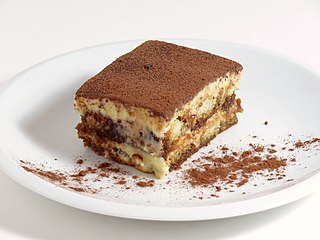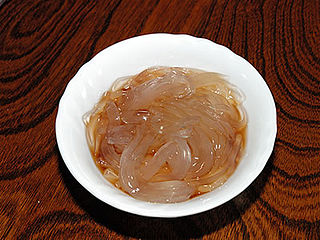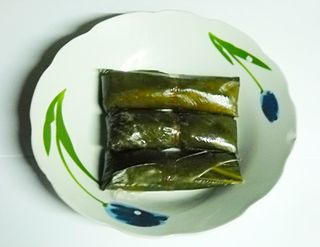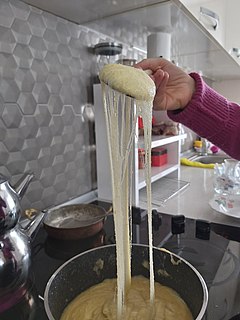
Tiramisu is a coffee-flavoured Italian dessert. It is made of ladyfingers (savoiardi) dipped in coffee, layered with a whipped mixture of eggs, sugar, and mascarpone cheese, flavoured with cocoa. The recipe has been adapted into many varieties of cakes and other desserts. Its origins are often disputed among Italian regions Veneto and Friuli Venezia Giulia.

Finnish cuisine is notable for generally combining traditional country fare and haute cuisine with contemporary continental style cooking. Fish and meat play a prominent role in traditional Finnish dishes in some parts of the country, while the dishes elsewhere have traditionally included various vegetables and mushrooms. Evacuees from Karelia contributed to foods in other parts of Finland in the aftermath of the Continuation War.

Malaysian cuisine consists of cooking traditions and practices found in Malaysia, and reflects the multi-ethnic makeup of its population. The vast majority of Malaysia's population can roughly be divided among three major ethnic groups: Malays, Chinese and Indians. The remainder consists of the indigenous peoples of Sabah and Sarawak in Malaysian Borneo, the Orang Asli of Peninsular Malaysia, the Peranakan and Eurasian creole communities, as well as a significant number of foreign workers and expatriates.

Ras malai or rossomalai or Rasamalei is a dessert originating from the eastern regions of the Indian subcontinent. The dessert is called rossomalai in Bengali, ras malai in Hindi, and Rasa Malei in Odia.

Chhena poda is a cheese dessert from the Indian state of Odisha. Chhena poda literally means Baked Cheese in Odia. It is made of well-kneaded homemade fresh cheese chhena, sugar is baked for several hours until it browns. Chhena poda is the only well known Indian dessert whose flavor is predominantly derived from the caramelization of sugar.

Acıbadem kurabiyesi is a traditional Turkish biscuit made of almonds, sugar and egg whites. The traditional recipes include a small amount of bitter almonds, which gives this cookie its name. However, because bitter almonds are not readily available, almond extract is typically used as a substitute. These biscuits are part of the stock-in trade of almost every bakery in Turkey, and are seldom made at home.

Angel cake is a type of layered sponge cake dessert that originated in the United Kingdom, and first became popular in the late 19th century.

Maruya is a type of fritter from the Philippines. It is usually made from saba bananas. The most common variant is prepared by coating thinly sliced and "fanned" bananas in batter and deep frying them. They are then sprinkled with sugar. Though not traditional, they may also be served with slices of jackfruit preserved in syrup or ice cream. Maruya are commonly sold as street food and food sellers at outdoor though they are also popular as home-made merienda snacks among Filipinos.

Tokoroten is a dish in Japanese cuisine made from agarophytes. Tokoroten has been eaten by the Japanese for over a thousand years. Tokoroten is thought to have been introduced to Japan from China during the Nara period. Tokoroten was traditionally made by boiling tengusa and then allowing the mixture to congeal into a jelly.

Cincin is a traditional kuih for the Bruneian Malay people in the states of Sabah, Malaysia as well in Brunei.

Kelupis is a traditional kuih for the Bruneian Malay people in the country of Brunei and in the states of Sabah and Sarawak in Malaysia. It is also a traditional snack for the Bisaya people as the three ethnics are ethnically related which is Lun Bawang/Lundayeh also create this kelupis especially on the wedding ceremony.

Jala is a traditional kuih from Sabah and Sarawak in Malaysia and Brunei. In Sarawak, it is known as the traditional snack for the Iban people. It is very different from the roti jala in Peninsular Malaysia.

Lamban is a traditional dessert for the Bruneian Malay people, Kedayan in Labuan and in the states of Sabah, Malaysia. The taste of Lamban is almost like the Malays ketupat or the Chinese's rice dumplings and kelupis of Lun Bawang / Lundayeh.
Punjung is a traditional dessert for the Bruneian Malay people and Kedayan in Labuan and in the states of Sabah, Malaysia.

Macun is a soft, sweet and colorful Turkish toffee paste. It is a street food that may be prepared with many herbs and spices. Macun originated from spicy preparations of Mesir macunu, a traditional Turkish herbal paste from the classical antiquity period. During classical antiquity, macun was consumed as a pharmaceutical medicine. It was historically served in a round tray with separate compartments for the various flavors, a serving style that has continued into modern times. The consumption of macun is a part of some Turkish customs.

Kuymak or Kachi is an Turkish dessert. Its primary ingredients are corn meal and cheese. It is also popular in Georgia, Azerbaijan and some regions of Caucasus.
Şıllık is a Turkish dessert crepe that is a specialty of the southeastern Urfa province. It is a thin dough made of milk and flour, similar to a crepe, filled with ground walnuts and topped with simple syrup and chopped pistachio. Some versions of the filling may include a mix of walnut and pistachio. Butter or Turkish grape molasses may optionally be added to the simple syrup sauce. Traditionally, lamb tail fat was used to fry the crepes. In Turkish the word şıllık means slut or hussy, so some women in the conservative province of Urfa are not comfortable ordering the dessert by name, preferring instead to allow a male relative to order it for them or simply asking for "that dessert".














